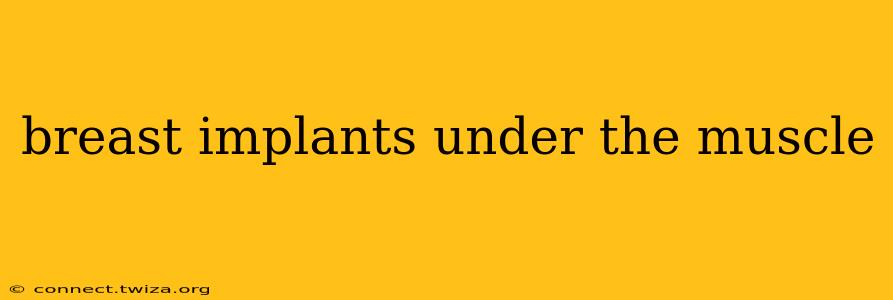Choosing the right breast augmentation technique is a deeply personal decision. Many women opt for placing breast implants under the pectoral muscle (submuscular placement), believing it offers certain advantages. This comprehensive guide explores the nuances of this procedure, addressing common questions and concerns.
What are the benefits of placing breast implants under the muscle?
Placing breast implants beneath the pectoral muscle, rather than directly on top of the chest muscle (subglandular placement), offers several potential benefits. One key advantage is improved cosmetic results. The muscle acts as a natural barrier, potentially concealing the implant's edges and creating a smoother, more natural appearance. This is particularly beneficial for women with thinner breast tissue. Furthermore, the muscle offers a degree of protection for the implant, potentially reducing the risk of capsular contracture (scar tissue formation around the implant) and rippling. Finally, some women find that submuscular placement leads to less palpable implants, meaning the implants feel less firm or noticeable to the touch.
What are the potential drawbacks of placing breast implants under the muscle?
While submuscular placement offers advantages, it's crucial to be aware of potential drawbacks. The most significant is increased recovery time and discomfort. Placing the implant under the muscle requires more extensive surgery, leading to greater post-operative pain, swelling, and bruising. The muscle itself can also become stiff and sore, restricting movement for a period of time. Additionally, implant malposition is a slightly higher risk with submuscular placement. This means the implant may shift or rotate after surgery, potentially requiring revision surgery. Finally, some women experience a longer period of numbness in the breast area due to the surgical disruption of nerves.
Are there any specific risks associated with placing breast implants under the muscle?
The risks associated with submuscular breast implant placement are similar to those of subglandular placement but can be slightly amplified due to the more invasive nature of the procedure. These risks include infection, bleeding (hematoma), seroma (fluid collection), capsular contracture (though potentially reduced), and implant rupture or deflation. Additionally, there's a small risk of damage to nerves or blood vessels during surgery, leading to complications such as persistent numbness or pain. It's imperative to discuss these risks with your surgeon before proceeding.
How long is the recovery time for breast implants placed under the muscle?
Recovery time varies significantly between individuals, depending on factors such as the extent of the surgery, individual healing capacity, and post-operative care. Generally, however, expect a longer recovery period compared to subglandular placement. You'll likely experience significant pain and swelling for the first few weeks, with gradual improvement over several months. Returning to strenuous activities should be delayed for at least 6-8 weeks, or as advised by your surgeon. Complete recovery and regaining full range of motion can take several months.
Is the pain level significantly higher with implants under the muscle?
Yes, it is generally accepted that the pain level is higher with submuscular placement of breast implants. This is due to the greater surgical trauma involved in creating a pocket beneath the pectoral muscle. Pain management is crucial during the recovery period, and your surgeon will likely prescribe pain medication. The intensity and duration of pain vary considerably between patients.
What are the alternatives to placing breast implants under the muscle?
The primary alternative to placing breast implants under the muscle is subglandular placement—placing the implant directly on top of the chest muscle. This is generally associated with a faster recovery time and less post-operative pain, but it might not offer the same level of cosmetic enhancement or implant protection as submuscular placement. Your surgeon can help determine the best approach based on your individual anatomy, preferences, and risk tolerance.
Disclaimer: This information is for general knowledge and does not constitute medical advice. Always consult with a qualified plastic surgeon to discuss your options and determine the best approach for your specific needs and circumstances. Individual results may vary.
